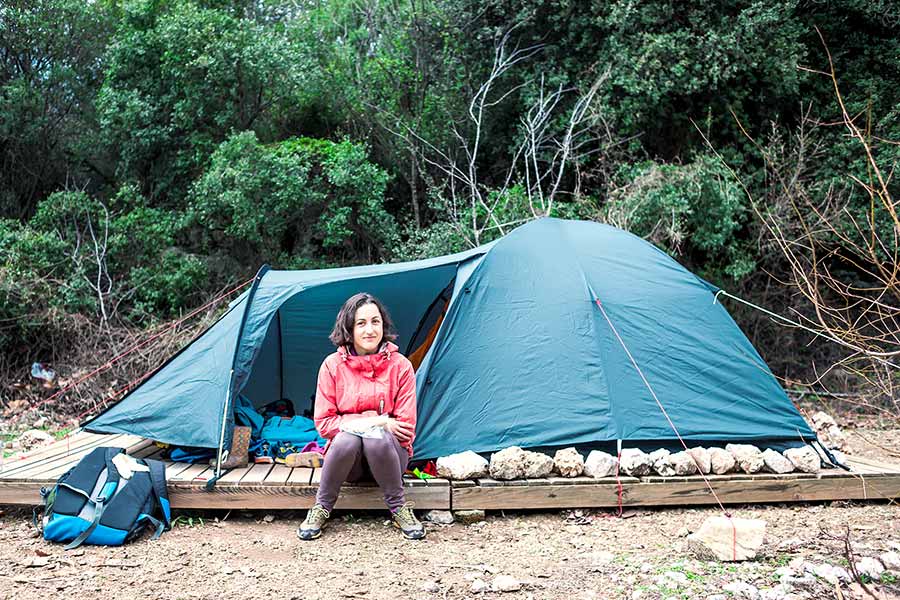
Picture this: you’re on a camping trip, surrounded by the beauty and serenity of nature. You’re enjoying a hike around the campsite when you unintentionally brush against some poison ivy. If you’re like most people (about 85 percent) who are allergic to poison ivy, you could be headed for an itchy skin rash followed by bumps and blisters. It’s not exactly the dream vacation you had in mind, right?
Avoid poison ivy, oak, and sumac by learning to identify them by their distinctive leaves, colors, berries, and growth patterns. Wear protective clothing, including gloves and long sleeves, when in areas where these plants may grow. Wash any exposed skin with soap and water immediately after contact.
While camping, it’s important to avoid these types of plants. One random touch can leave you with an itchy red rash lasting several weeks. But unfortunately, even the most experienced campers can accidentally come in contact with one. This post will help you identify three common poisonous plants and give tips on avoiding them and staying safe. So, let’s get started.
Recognizing Poison Ivy, Oak, and Sumac
Poison ivy, oak, and sumac contain an oily resin called urushiol. This resin is responsible for the allergic reaction many people experience when they come into contact with these plants. Symptoms of an allergic reaction to urushiol can range from mild irritation to severe blistering and swelling.
Remember, as a child, hearing:
- Leaves of three, let it be.
- Berries white, run in fright.
- Hairy vine, no friend of mine.
That was all good advice. You’ll learn why after reading the following sections.
Poison Ivy:
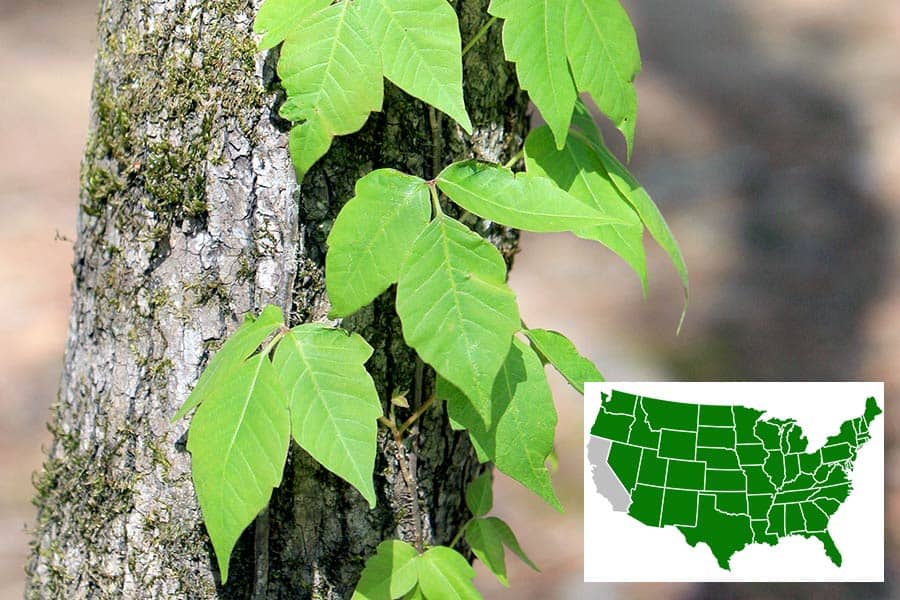
This plant is found in most parts of the United States. It can grow as a vine or a shrub. Its leaves can be glossy or dull and have a distinct three-leaf pattern. The edges of the leaves can be smooth or toothed. In spring, the leaves are reddish, and in summer, they are green. In the fall, they may turn yellow, orange, or red. The plant may also have greenish-white flowers and whitish-yellow berries.
Poison Oak:

Poison oak can grow as a vine or shrub in the western and southern United States. The leaves are green and fuzzy and grow in clusters of three. It can have white flowers in the spring, and the leaf shape resembles an oak leaf and can be lobed or toothed and may also have yellow-white berries. The leaves can range from green to orange to purply red.
Poison Sumac:
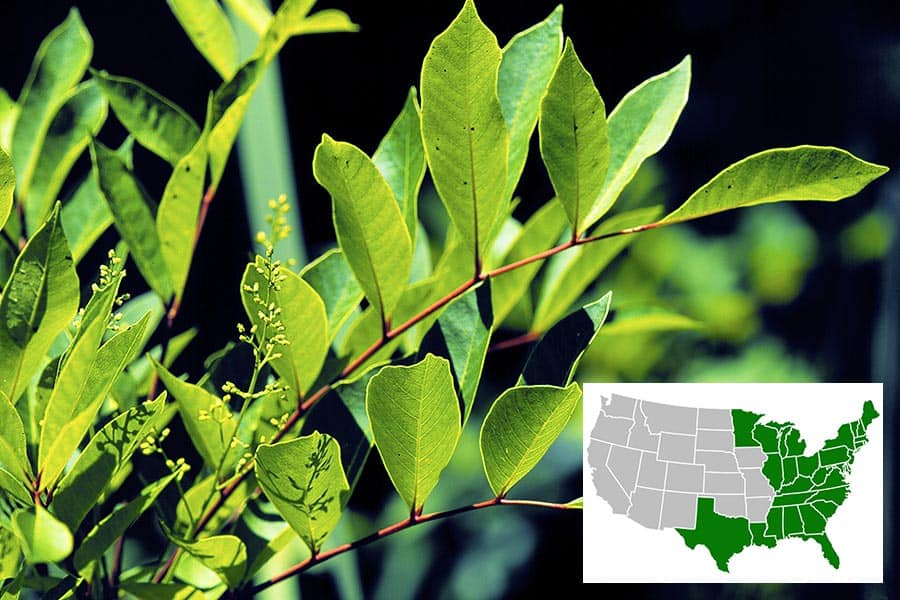
This plant is found in bogs and swamps in the northeast, midwest, and parts of the southeast. It can grow as a tall shrub or a small tree. Each leaf has clusters of seven to 13 smooth-edged leaflets. In spring, the leaves are orange, and in summer, they are green. As fall progresses, they may turn yellow, orange, or red. The plant may also have yellow-greenish white flowers and whitish-green fruits that hang in loose clusters.
Protect Yourself from Nature’s Dangers
Avoiding contact is the most reasonable way to prevent an allergic reaction to poison ivy, oak, or sumac. Below are a few tips that you should know.
- Learn to recognize these plants and avoid them.
- Wear long sleeves and pants when hiking or working where these plants may be present.
- In case of plant exposure, it is necessary to promptly remove the oils from the skin. Removing it can be achieved by washing it with ordinary soap and repeating several times. Alcohol-based wipes are also available for this purpose.
- Remove your clothing and wash them immediately if you encounter one of these plants. Do not touch any other part of your body with the contaminated clothing.
- Never burn poison ivy, oak, or sumac. Burning these plants can release the urushiol oil into the air, which can cause a severe allergic reaction if inhaled.
Symptoms of an Allergic Reaction
An allergic reaction to these poisonous plants can cause a rash, itching, redness, and blistering on the skin. These symptoms typically appear within 12 to 72 hours of exposure and can last 2 to 3 weeks.
You may experience difficulty breathing if the plant has been burned and the smoke is inhaled.
In severe cases, the rash may spread to other parts of the body, leading to swelling, fever, and difficulty breathing. It’s essential to seek medical attention if you experience these symptoms or if the rash appears on your face or genitals.
Once the rash appears, it will have to run its course. Hence, avoiding contact with the plants is the most effective treatment. Therefore, it is crucial to identify the plants and refrain from touching them.
Mild cases of an allergic reaction can be treated at home with soothing lotions and a few other alternatives.
Van Camping Life Fact: Most people think only the poison ivy leaves are poisonous, while in fact, all parts of the plant are poisonous: roots, vines, stems, leaves, flowers, and berries.
Other Posts of Interest
- 7 Unique Tent Camping Experiences To Try: Dare To Be Different
- Can You Pitch A Tent On Gravel?
- Is it Safe to Sleep in a Van? The Essential Guide
- What Is A Pie Iron?
Poison ivy is the most widespread of the three in the US. Therefore we will delve into some common questions people have about it.
What Plants are Mistaken for Poison Ivy?
Many plants are regularly misidentified as poison ivy. Here is a couple that people mistake for it:
Boxelder: These trees, widely found in North America, often have leaves that resemble the leaves of poison ivy, with three to eleven leaflets. Though this is a tree, young boxelder plants sometimes confuse people.
Boxelder leaves are arranged oppositely, unlike poison ivy. This means the compound leaves are positioned directly across from each other on the stem. Whereas poison ivy leaves are arranged alternately along the vine.
Virginia Creeper: This plant, also known as Parthenocissus quinquefolia, bears compound-palmate leaves with five (but occasionally 3 or 7) saw-toothed leaflets that turn bright red in the fall. It has small greenish flower clusters and gets bluish-black fruit.
It is hard to tell the difference between the two plants by looking only at the vine without seeing the leaves or fruit.
What Time of Year is Poison Ivy the Worst?
The potency of the rash-causing chemical urushiol, in the poison ivy plant, can vary depending on the time of year.
In general, the most critical period for poison ivy exposure occurs during the warmer months, especially from late spring to early fall. This is because it goes into an active growth phase during this period, and sap levels increase. In other words, the more vigorously the plant is growing, the higher the concentration of urushiol on the surface of the leaves.
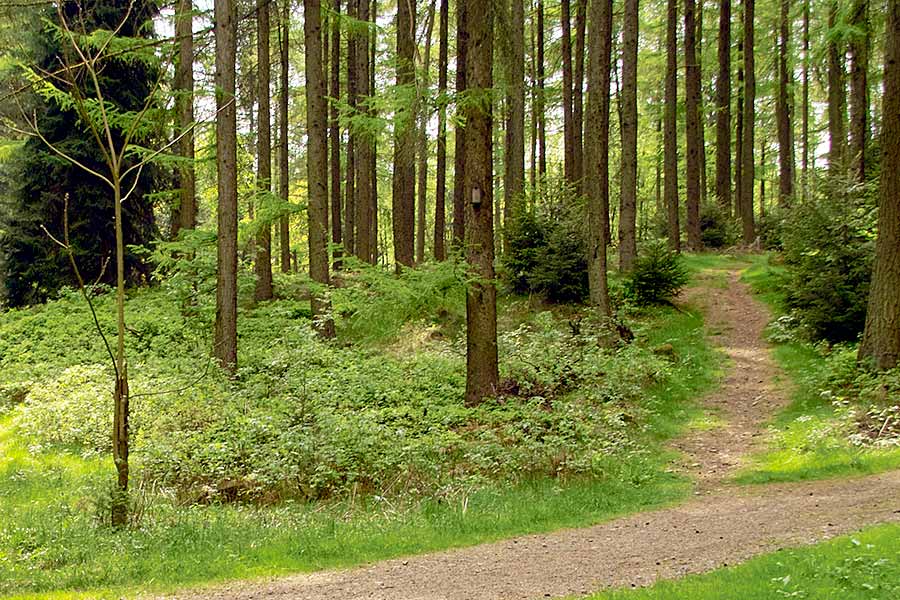
Additionally, factors such as excessive heat, humidity, and moisture in the air can intensify the potency of the chemical. As a result, cities and states in warmer regions of the United States report higher rates of poison ivy rashes in their population.
It is important to be vigilant and avoid contact with the plants all year round, even when the plant may not be in a period of active growth—wearing protective clothing when outdoors, such as long-sleeved shirts and pants, can also significantly reduce instances of contact with the leaves or stem of the plant.
Can Dogs Spread Poison Ivy to Humans?
While dogs are usually not sensitive to the chemical urushiol found in poison ivy, they can indeed spread the oil to humans, leading to rashes and other allergic reactions.
Dogs can get urushiol on their fur, which they can transfer to people through direct contact with the animal or by coming into contact with surfaces and objects the dog has rubbed against.
If the oil remains on the fur for an extended period, there is a high likelihood of it being transferred from the dog’s coat onto clothing, furniture, or household items that a person comes into contact with, leading to unwanted exposure to the toxic ivy resin.
Pet owners should take precautions to minimize the chances of their dogs spreading poison ivy. For example, they could immediately wipe the dog’s paws and fur with a damp cloth after outdoor playtime, particularly in wooded areas. Bathing the dog with lukewarm water can also remove the toxic resin on its coat if it has come into contact with it, particularly in the animal’s paws or underbelly, where it is most likely to accumulate.
If a person suspects that they have been exposed owing to their dog’s contact, they should thoroughly wash their skin, clothing, pets, or any objects that come into contact with urushiol oil to prevent an allergic reaction.
Does Poison Ivy Cause Permanent Skin Damage?
In most cases, the rash caused by poison ivy does not result in permanent skin damage. However, in some rare cases, blistering and oozing rashes may lead to skin infections, which could leave scars.
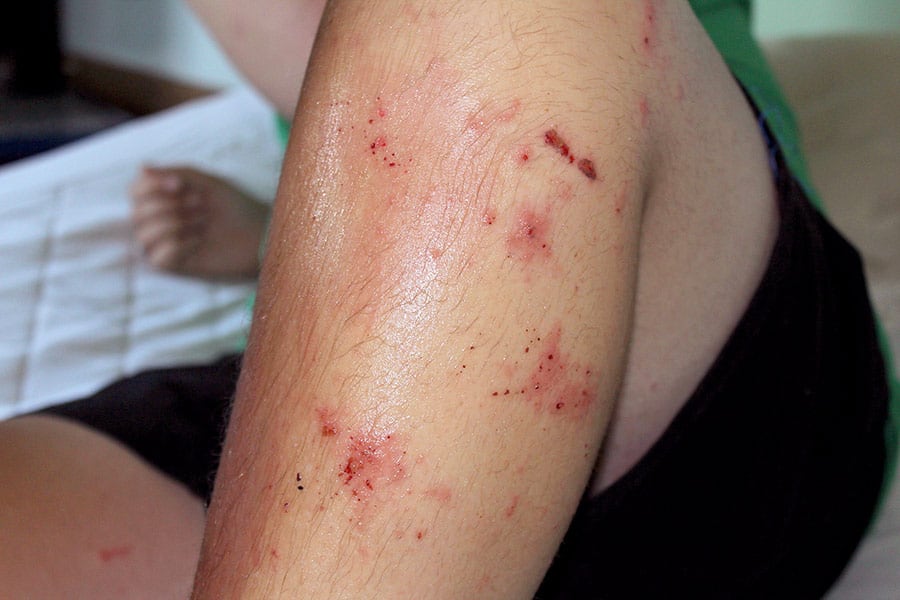
If an individual repeatedly comes in contact that leads to rashes, they may develop increased sensitivity to urushiol, making their reactions even more severe. This condition is known as allergic contact dermatitis, and it can become chronic, requiring medical attention to treat effectively.
A more severe skin reaction called “post-inflammatory hypopigmentation” may also occur. This condition leads to a loss of skin pigment at the site of the rash, which may take an extended period to recover. However, it is worth noting that post-inflammatory hypopigmentation is rare and mainly affects individuals with darker skin tones.
While poison ivy rashes can be uncomfortable and take time to heal, they do not usually cause permanent skin damage. However, taking proper precautions to avoid contact with the plant is essential to prevent potential allergic reactions. Again, if you come into contact with poison ivy, immediately wash your skin with soap and water to remove the urushiol oil and reduce the chances of experiencing an allergic reaction.
Keep Your Distance
While nature can be a rewarding and awe-inspiring experience for individuals camping and enjoying the beauty of the outdoors, it can also be problematic when people or pets come in contact with poisonous plants—as such, learning how to identify the most common plants, such as poison ivy, sumac, and oak can help avoid the problem.
One can stay clear of these plants by paying attention to distinguishing features such as leaf structure and avoid the unpleasant symptoms they can cause. Therefore, campers should educate themselves before going out into nature, so they can appreciate the beauty of the wilderness while staying rash free.





